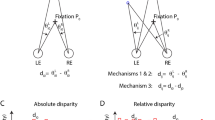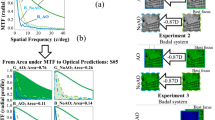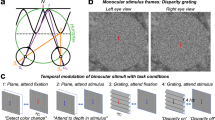Abstract
WRIGHT'S1 apparatus for measuring stereoscopic acuity has been modified to enable the measurements to be extended to wider separation between the tested targets. When operated in the dark, it provided two illuminated circular apertures seen against a black background. The experiments were carried out under two conditions of observation. Under condition A, the observer looked binocularly at one of the targets (P) and then to the second (Q). Under condition B the observer looked at P only but saw Q extrafoveally. In each case he was asked to estimate their relative apparent distances, and judge whether Q was nearer or farther than P.
This is a preview of subscription content, access via your institution
Access options
Subscribe to this journal
Receive 51 print issues and online access
$199.00 per year
only $3.90 per issue
Buy this article
- Purchase on Springer Link
- Instant access to full article PDF
Prices may be subject to local taxes which are calculated during checkout
Similar content being viewed by others
References
Wright, W. D., Proc. Phys. Soc., B, 64, 289 (1951).
Valentine, J. A., Brit. Med. J., ii, 657 (1923).
Ogle, K. N., Proc. Phys. Soc., B, 66, 513 (1953).
Author information
Authors and Affiliations
Rights and permissions
About this article
Cite this article
RADY, A. Relative Contribution of Disparity and Convergence to Stereoscopic Vision. Nature 175, 305–306 (1955). https://doi.org/10.1038/175305a0
Issue Date:
DOI: https://doi.org/10.1038/175305a0
Comments
By submitting a comment you agree to abide by our Terms and Community Guidelines. If you find something abusive or that does not comply with our terms or guidelines please flag it as inappropriate.



